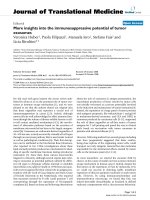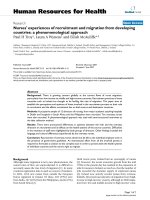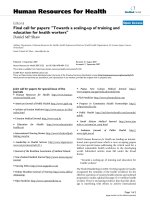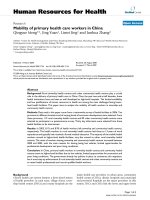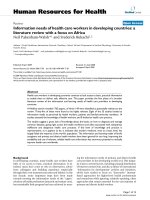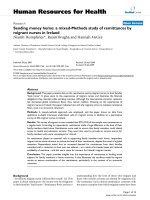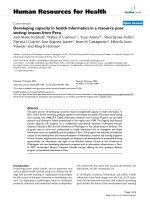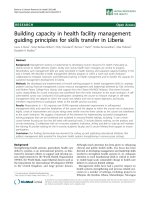báo cáo sinh học:" “More money for health - more health for the money”: a human resources for health perspective" pdf
Bạn đang xem bản rút gọn của tài liệu. Xem và tải ngay bản đầy đủ của tài liệu tại đây (1000.02 KB, 10 trang )
RESEARCH Open Access
“More money for health - more health for the
money”: a human resources for health perspective
James Campbell
1*
, Iain Jones
2
and Desmond Whyms
3
Abstract
Background: At the MDG Summit in September 2010, the UN Secretary-General launched the Global Strategy for
Women’s and Children’s Health. C entral within the Global Strategy are the ambitions of “more money for health”
and “more health for the money”. These aim to leverage more resources for health financing whilst simultaneously
generating more results from existing resources - core tenets of public expenditure management and governance.
This paper considers these ambitions from a human resources for health (HRH) perspective.
Methods: Using data from the UK Department for International Development (DFID) we set out to quantify and
qualify the British government’s contributions on HRH in developing countries and to establish a baseline. To
determine whether activities and financing could be included in the categorisation of ‘HRH strengthening’ we
adopted the Agenda for Global Action on HRH and a WHO approach to the ‘working lifespan’ of health workers as
our guiding frameworks. To establish a baseline we reviewed available data on Official Development Assistance
(ODA) and country reports, undertook a new survey of HRH programming and sought information from
multilateral partners.
Results: In financial year 2008/9 DFID spent £901 million on direct ‘aid to health’. Due to the nature of the
Creditor Reporting System (CRS) of the Organisation for Economic Co-operation and Development (OECD) it is not
feasible to directly report on HRH spending. We therefore employed a process of imputed percentages supported
by detailed assessment in twelve countries. This followed the model adopted by the G8 to estimate ODA on
maternal, newborn and child health. Using the G8’s model, and cogn isant of its limitations, we concluded that UK
‘aid to health’ on HRH strengthening is approximately 25%.
Conclusions: In quantifying DFID’s disbursements on HRH we encountered the constraints of the current CRS
framework. This limits standardised measurement of ODA on HRH. This is a governance issue that will benefit from
further analysis within more comprehensive programmes of workforce science, surveillance and strategic
intelligence. The Commission on Information and Accountability for Women’s and Children’s Health may present
an opportunity to partially address the limitations in reporting on ODA for HRH and present solutions to establish a
global baseline.
Background
At th e MDG Summit in September 2010, the United
Nations Secretary General (UNSG) launched the Global
Strategy for Women’s and Children’s Health [1]. The strat-
egy sets out the key areas where action is urgently
required to enhance financing, strengthen policy and
improve service delivery. It represents, in the UNSG’sown
words, an opportunity “to improve the health of hundreds
of millions of women and children around the world, and
in so doing, to improve the lives of all people” [2]. Central
within the Global Strategy are the ambitions of “more
money for health” and “more health fo r the money”.
The objectives aim to leverage “mo re” resources and
“more” results. They refer to the additional financing
required to achieve the Millennium Devel opment Goals
for health ("spending on health in low-income countries
needs to be raised from an estimated US$ 31 billion [in
2009] to US$67-76 billion per year by 2015” (more money
for health)) and the necessity to improve the use of exist-
ing financial resources to strengthen health systems and
scale-up efficient, effe ctive and equitable services that
* Correspondence:
1
Instituto de Cooperación Social, Integ rare (ICSI), Barcelona, Spain
Full list of author information is available at the end of the article
Campbell et al. Human Resources for Health 2011, 9:18
/>© 2011 Campbell et al; licensee BioMed Central Ltd. This is an Open Access article distributed under the terms of the Creative
Commons At tribution License ( nses/by/2.0), which permits unrestricted use, distribution, and
reproduction in any medium, provided the original work is properly c ited.
result in improved health outcom es (more health for the
money). Both are core tenets of public expenditure man-
agement and governance; equally applicable to domestic
and international expenditures (see Figure 1).
This paper responds to the two ambitions in the
UNSG’s Global Strategy from a human resources for
health (HRH) perspective. It draws upon formative moni-
toring and evaluation activities within the United Kingdom
of Great Britain and Northern Ireland (United Kingdom)
Department for International Development (DFID) to
quantify and qualify the British Government’s support to
HRH. To paraphrase the Global Strategy the paper reviews
issues related to “more HRH for the money” and “mo re
money for HRH”. A key purpose of the research was to
address the feasibility of establishing a baseline from
which to measure ‘more’.
The paper is presented in three parts. In the first we
describe the methodology employed in establishing a base-
line. The second part presents a short overview of the
results before focusing on the quantitative component
related to Official Development Assistance (ODA) f or
HRH. This leads to a discussion, drawing on the peer-
reviewed literature, of the OECD’s Creditor Reporting Sys-
tem (CRS) in relation to HRH strengthening in the final
part.
Methods
In order to determine whether activiti es and financing
could be included in the categorisation of ‘HRH strength-
ening’ we adopted two guiding frameworks: the Agenda
forGlobalActiononHRH[3](seeFigure2)andWHO’s
approach to the working lifespan of health workers [4]
(see Figure 3). The Agenda for Global Action on HRH and
the accompanying Kampala Declaration [5] were pre-
pared by the Global Health Workforce Alliance (GHWA)
in 2008. These have since been recognised by the G8 as
tools to guide collective action [6,7]. Comparing British-
funded activities against the Agenda for Global Action
served a dual purpose: to be one of the first bilateral agen-
cies to classify British activities against each of the six
action areas in the Agenda (thus evaluating whether UK
programming is consistent with this widely-adop ted con-
sensus for action on HRH) and for subsequent internal
and external repo rting (i.e. for reporting UK activities on
HRH to the G8 as required by their annual Accountability
Framework). The World Health Organization (WHO)
‘working lifespan strategies’ is promoted as a roadmap
for training, sustaining and retaining the workforce [4]
and provided a visual tool to assess and categorise UK-
supported activities (see Figure 2 and 3).
Three components were included in the research: a
desk-based analysis of ODA, an in-depth review in four
countries and a survey of HRH programming across
twelve countries.
We conducted a desk-based analysis of the British ODA
in the 2008/9 financial year to quantify the volume an d
percentage of DFID spending on ‘aid to health’ that was
committed to HRH strengthening across all countries. We
analysed data from the 2008/9 financial year (FY) (the
most recent and complete for both multilateral and bilat-
eral sector spending) to base our assessment on ODA dis-
bursements rathe r than projections, extracting data from
DFID’s management information system. This relational
database disaggregate s health expenditure by sector and
sub-sector codes as per the Creditor Reporting System
(CRS) of the Organisation for Economic Co-operation and
Development (OECD). Due to limitations in the coding
structure of the CRS we were aware that total volumes
and percentages could not be calculated purely by sum-
ming the specific sub-sector codes for HRH activity.
Instead we elected to calculate rational estimates on the
HRH expenditures within other sub-sector codes. These
rational estimat es followed a process of imputed percen-
tages, mirroring the exercise developed by G8 partners to
assess and benchmark ODA for maternal, newborn and
under-five child health (MNCH) [8]. The MNCH exercise
was undertaken in preparation for the G8 Statement in
June 2010 announcing the Muskoka Initiative on MNCH
[9]. It provided an estimate of G8 spending on MNCH
(with supporting rationale), overcoming the limitations of
the Creditor Reporting System, and a baseline for future
accountability mechanisms (see Table 1).
Figure 1 “More money for health - more health for the money”.
Source: Global Strategy for Women’s and Children’s Health [3].
Figure 2 Six action areas from the Agenda for Global Action on
HRH. Source: Global Strategy for Women’s and Children’s Health [3].
Campbell et al. Human Resources for Health 2011, 9:18
/>Page 2 of 10
Table 1 G8 Health Working Group - imputed percentages for bilateral expenditure on MNCH
DAC CRS Code Imputed Percentages
12110 Health policy and administrative management 40%
12181 Medical education/training 40%
12191 Medical services 40%
12220 Basic health care 40%
12230 Basic health infrastructure 40%
12240 Basic nutrition 100%
12250 Infectious disease control 40%
12261 Health education 40%
12262 Malaria control 88.5%
12263 Tuberculosis control 18.5%
12281 Health personnel development 40%
13010 Population policy and administrative management 40%
13020 Reproductive health care 100%
13030 Family planning 100%
13040 STD control including HIV/AIDS 46.1%
13081 Personnel development for population and reproductive health 100%
14030 Basic drinking water supply and basic sanitation 15%
14031 Basic drinking water supply 15%
14032 Basic sanitation 15%
51010 General budget support 4%
Source: Adapted from G8 Information Centre, University of Toronto. />Figure 3 WHO: Working lifespan strategies. Source: World Health Report 2006 [4].
Campbell et al. Human Resources for Health 2011, 9:18
/>Page 3 of 10
The process of imputed percentages for estimating a
specifictypeofspendingfrom a sub-sector code is one
with methodological limitations. Being cognisant of the
huge challe nges in measuring ODA we differed from the
G8’s MNCH exercise in Table 1 by electing to use a
range in our rational estimates of 10% (low and high
being +/-5%) to estimate an approximate value. Each esti-
mate of HRH spending in sub-sector codes was based on
the data and trends emer ging from the detailed analysis
of the individual country portfolios (components 2 and 3
of the research discussed below). We compared technical
activities and financial allocations within and across
country programmes to estimate the volume of funds for
HRHstrengthening.DFIDcolleagues were subsequently
invited to challenge the rationaleandlogicinouresti-
mates. In some instances our estimates were revised
downwardstoerronthesideofcaution.Wealsotested
the estimates and resulting average against total ‘aid to
health’ spending in previous financial years (2005-6,
2006-7 and 2007-8) to assess if this would significantly
change over more than one financial year, and found this
not to be the case.
In support of the ODA exercise the research included
two further components to qualify British-supported
activities and to develop and test our rationale for the
imputed percentages in the sub-sector codes. Four
countries had earlier participated in an in-depth analysis
of HRH programming as part of the United Kingdom’s
joint work on ‘ Taking Forward Action on HRH’ with
the USA’sPresident’s Emergency Programme for AIDS
Relief (PEPFAR). The four countries were selected on
the basis of being signatories to the International Health
Partnership and related initiatives ( IHP+) and ‘focus’
countries for PEPFAR at that time. These studies were
conducted jointly with the Ministries of Health in the
respective countries and the USA’s Office of the Global
AIDS Coordinator (OGAC). Reviews were undertaken
in Ethiopia, Kenya, Mozambique and Zambia in the per-
iod 2008-9. Key informant interviews and focus groups
were combined with desk reviews of technical and
financial documentation to summarise existing HRH
strengtheni ng activities and discuss future opportunities
for enhanced programming and alignment [10-14].
The third component was a multi-country survey in the
latter half of 2009. We invited DFID’s residential health
advisers in 22 priority countries to relate DFID’sinvest-
ments in HRH strengthening (including general budget
support, sector support and direct programming) to the
six recommended action area s in the Agenda for Global
Action on HRH. Country health advisers completed a
standardized questionnaire to identify techni cal activities
and financial spend ing. This facilitated a detailed assess-
ment of ODA for HRH and enabled a comparison against
the cod ing of expenditure in DFID’ s internal system.
Country returns were reviewed and, where required, clari-
fication questions were conducted by telephone and/or
email. Response rates (n = 12) from DFID’s country advi-
sors determined the inclusion of countries in the survey.
The three components provided a rich data set for
internal analysis. Twelve countries–Bangladesh, Cambo-
dia, the Democr atic Republic of Congo, Ethiopia, Ghana,
India, Kenya, Mozambique, Nigeria, Sierra Leone, South
Africa, Zambia and Zimbabwe (South Africa being the
only country among these not categorised as an HRH
‘cr isis’ country)– from DFID’s portfolio of development
support participated in the country visits and/or the
multi-country survey (nine from sub-Saharan Africa,
three from South-East Asia). The data on financial pro-
gramming and disbursements enabled rational estimates
to be made for the imputed percentages on ODA. Initial
findings were synthesised and discussed prior to scruti ny
and internal revie w from DFID colleagues to inform
future programming.
Results
Of the twelve countries, eleven are listed as having a cri-
tical s hortage of hea lth workers in the 2006 World
Health Report. Density of health professionals (doctors,
nurses and midwives per 1000 population) in the eleven
countries is in the range of 0.25 to 2.13/1000, as against
the threshold of 2.28/1 000, below which WHO has sug-
gested that high coverage of essential interventions,
including skilled attendance at birth, is very unlikely.
The sum of the estima ted health workforce shortages in
these eleven ‘crisis’ countries is 2.1 mill ion, or half o f
the global shortage of 4.2 million [4].
In FY 2008/9, the latest available data for both multilat-
eral and bilateral sector disbursements, DFID spent £901
million on direct ‘aid to health’. This was approximately a
75:25 split through bilateral and multilateral channels
[15]. Of note is that 56% of DFID’s bilateral health spend-
ing in 2008/09 was disbursed to th e eleven countries
highlighted above. This confirms that just over one half
of the UK’s bilateral support is targeted to those HRH
‘crisis countries’ that exhibit one-h alf of the global work-
forceshortageandprovidesaweightedsampleforthe
rationale underpinning the imputed percentages.
ODA for HRH strengthening
Reflecting item 6 in the Agenda for Global Action, to
secure ‘additional and more productive investment in the
health workforce’, we set out to quantify the baseline of
current HRH spending across both bilateral and multilat-
eral channels. The CRS collates aid flows at activi ty level.
Two sector codes, ‘health’ and ‘population policies/pro-
grammes and reproductive health’,aresub-dividedby
seventeen sub-sector codes. Collectively these are consid-
ered ‘aid to health’ [16,17]. DFID’s internal man agement
Campbell et al. Human Resources for Health 2011, 9:18
/>Page 4 of 10
informatio n s ystem, known as “ARIES ”,followstheCRS
sector and sub-sector coding to facilitate statistical and
annual reporting on ODA. Within ARIES these are
referred to as ‘input sector codes’.
In tracking the bilateral spending, an immediate diffi-
culty arises in reporting ODA committed to HRH
strengthening. Of the 17 codes for ‘aid to health’ (note
there are other OECD codes relating to public sector pol-
icy and management, which are not traditionally ‘aid to
health’ but which may also capture spending related to
human resource management) only 3 - the “81’s” -provide
specific wording related to education/training and person-
nel development: 12181: Medical education/training;
12281: Health personnel development; 13081: Personnel
development for p opulation and reproductive health. Of
these, one is only for activities supporting tertiary services
(12181: medical education/training). These 3 codes are not
representative of the breadth and depth of DFID’s current
HRH programming or the recommended activities in the
Agenda for Global Action. Reporting HRH spending
based only on the figures captured in these th ree sub-
sector cod es would generate figures of little value as well
as obscuring the more complex reality of HRH strengthen-
ing recognised by Piva and Dodd (2009) [18]
This dilemma is recognised by DFID’s internal system. It
allows up to eight input sector codes to be assigned to ca p-
ture the multiple elements of health programming. Where
more than one code is indicated, then the proportion of
the l ifetime budget expected to be spent in each sub- sector
must be indicated as a percentage, and the total must sum
to 100%. This system provisionally enables disaggregated
data to more closely reflect the actual investments.
However, even disaggregated data by input sector code
may still require an assessment of the percentage of funds
dedicated to HRH. For instance, the UK is providing £135
million to Ethiopia in pooled-funds for ‘Protec ting Basic
Services’. A WHO study notes that Ethiop ia’s Health
Extension Program (HEP) particularly benefits from this
programme, and around 6-7% (USD 72-84 million) of the
first phase of the pooled-funding was used for direct salary
support for health workers [19]. In this particular example,
DFID’s investment is recorded against Poverty Reduction
Budget Support (attributed to health); basic health care;
infectious disease control; and reproductive health care.
Even with disaggregation, the HRH spend still remains
obscured.
Offsetting these coding and categorisation issues there-
fore requires a detailed understanding of context. This was
provided by the qualitative components of the research
and enabled the construction of estimated percentages
supported by rational assumptions. Continuing with the
Ethiopia exa mple, DFID funding suppor ts the govern-
ment’s recurrent costs, the rapid expansion of the health
workforce and salary support. This includes the training
and deployment of 30 000 health extension workers. In
this instance we estimated that a range of 25%-30% of the
budget support may be indirectly strengthening HRH.
Whilst this ‘rational’ approach may provide greater
insig hts into the realistic volum e of HRH investment, we
have to recognise its methodological weaknesses and pro-
vide caveats alongside any final estimates.
Estimating the percentages and volumes of multilateral
expenditure on HRH comes up against similar problems
to the bilateral expenditures (the channels include core
contributions to multilateral agencies and specific com-
mitments to the Global Fund for AIDS, TB and Malaria
(GFATM), the Global Alliance for Vaccines and Immuni-
sation (GAVI) and the International Financing Facility
for Immunisation ( IFFIm)). While we could calculate a
three-year average of the multi laterals’ or global partner-
ships’ disbursement data as reported to the CRS it may
only reflect the 3 specific codes (assuming data is cap-
tured at this disaggregate level) and not the wider HRH
activities. We therefore sought to review existing docu-
mentation to provide the rationale for our estimates,
accepting that the principle of the ‘primary’ code in
OECD aggregate reporting masks the commitment to
HRH. Our focus was on the European Commission, the
WorldBankandtheGlobalFundforAIDS,TBand
Malaria (GFATM) a s the three largest recipients of
DFID’s multilateral health investments.
We first queried the CRS database reco rds (using the
Query Wizard for Information on Development Statis-
tics; accessed 10 March 2010) for the World Bank and
the GFATM (the EC was not included as there is limited
disaggregated data for its ‘aid to health
’).
No disburse-
ments on the three specific sub-sector codes - the “81’s” -
are indicated by the Bank in their 2008 data and equally
no data is reported by the GFATM in the period 2003-
2008. For the Global Fund this is at odds with their 2009
narrative that it has supported 8.6 million “person epi-
sodes” of training since 2004 [20]. Equally , HRH
strengthening is evident in the Global Fund’s cross-cut-
ting health systems strengthening activities (including
direct salary support to health workers), many of the
approved country applications and the Fund’s own statis-
tics. However, GFATM reports offer differing analysis
and information on how much it commits to HRH
investment and activities. The 2009 report suggests that
35% of all funding has been for systems strengthening,
including increasing the number, skills and competencies
of health wor kers. Meanwhile a survey across 65% of its
active portfolio in 2007 indicated that 25% of all funds
are allocated to human resources and training, and 42%
of all activities in Board-approved Round 8 proposals
related to human resources and training [21]. The var-
ious interpretations of the core data, without specific
attention to actual HRH investment as a percentage of
Campbell et al. Human Resources for Health 2011, 9:18
/>Page 5 of 10
total spending and without year-on-year comparison
combine to confuse.
Drawing little information from the CRS we therefore
requested feedback directly from the European Commis-
sion (EC), the World Bank and the GFATM. The EC was
unable to provide an estimate but did qualify current
expenditure within their Programme for Action on HRH
[22] and related activities under the Investing in People
budget line. Indicative figures on HRH spending were pro-
vided as a percentage of aid to health expenditure in the
last five years by the World Bank and the GFATM. These
were 18% and 21% respectively. The Bank’s indicative esti-
mate came from a sample of approximately 30 pro-
grammes. The Global Fund’s 21% figure relates to an
HRH investment of circa $1.5 billion in Rounds 5 to 9.
Whilst both these figures have to be treated with the same
appropriate caution as DFID’s internal estimates of its
bilateral investment, they nonetheless provided some
external assessment to work with.
Table 2 presents the final calculations on estimated
spending on HRH strengthening, including bilateral and
multilateral channels. The imputed percentages from our
representative sample w hen applied across the total ‘aid
to health’ indicate the volume of ODA to HRH is in the
range of £200-£285 million (equivalent to a low of 22%
and a high of 32%). For internal purposes we therefore
concluded with a working figure in the lower half of the
range of ‘approximately 25%’ (See Table 2).
Discussion
This research was developed to provide strategic intelli-
gence for internal discussion within DFID. An informed
baseline on HRH activities would support t he explora-
tion of future programming and financing scenarios as
the UK developed its 2011-2015 programme of aid to
health. Additionally the results would be available for
discussion with partners and civil society and in
responses to British parliamentary questions [23,24].
It was conducted against a backdrop of international
commitments to meet development spending targets,
increasing attention to results, value-for-money, the ‘Dec-
ade for Action on HRH’ called for in the 2006 World
Health Report and r evised projections on the financing
needs for the health MDGs in the lead up to the 2010
MDG Summit. A key consideration was the UK Govern-
ment’s commitment to meeting the target of 0.7% of
Gross National Income on development spending by
2013. Deputy Prime M inister Nick Clegg’s speech at the
United Nations General Assembly in September 2010
outlined this commitment, emphasising the accountabil-
ity for targeted investments and results:
“So my message to you today, from the UK government,
is this - we will keep our promises; and we expect the rest
of the international community to do the same. For our
part, the new coalit ion government has committed to
reaching 0.7% of GNI in aid from 2013 - a pledge we will
enshrine in law. That aid will be targeted in the ways we
know will make the biggest difference” [25].
The UK messag ing on “more resources” and “mo re
results” was further articulated by the Secretary of State
Andrew Mitchell in October 2010: “ we have a particular
duty to show that we are achieving value for money.
Results, transparency and accountability will be our
watchwords and will define everything we do” [26].
This emphasis on results and enhanced accountability
is not restricted to the UK Government. T he UNSG’s
Global Strategy and the outcome document from the
MDG Summit both recognise this. A recently estab-
lished Commission on Information and Accountability
for Women’s and Children’s Health [27] highlights this
even further. Of note is that the two working groups
convened by the Commission are respectively focused
on ‘Accountability for Resources’ and ‘Accountability for
Results’. The same principles of accountability and
transparency are inherent in the aid effectiveness agenda
[28] and explicit in the Centre for Global Development’s
recent Report on the Quality of Official Development
Assistance Assessment (QuODA) [29].
Applying the same considerations to HRH strengthening
was therefore a logical extension of this emphasis. The
results demonstrate that DFID is supporting an active
HRH portfolio working with nation al partners across the
range of priority actions recommended in the Agenda for
Global Action. This includes developing capacity for
human resource management, expansion of pre-service
education and initiatives to support rural deployment and
retention: essential elements to get the right health worker
in the right place at the right time. In tackling the quantifi-
cation of ODA for HRH the internal exercise raised a
number of issues that are relevant to a wider external
audience. These are explored further below.
The difficulties in conducting detailed analysis of ‘aid to
health’ or sub-sectors of this is an acknowledged issue
[18,30-32]. It is not unique to HRH. However, in narrow-
ing the focus to ODA for HRH, we have identified a
number of issues. These highlight the methodological
challenges to assess and routinely measure donors’
investments in HRH strengthening.
Firstly, there is a major disconnect between disburse-
ments on HRH and the creditor reporting system. The
current reporting framework, described by WHO as ill-
adapted to isolating HRH expenditures [33], results in
the statistic of less than 4% of “aid to health” being d edi-
cated to training and personnel development. Whilst the
OECD acknowledges that training is itself only a small
part of workforce development and dramatically under-
states the workforce strengthening activities of d onors it
concedes that the real share of ODA to HRH cannot be
Campbell et al. Human Resources for Health 2011, 9:18
/>Page 6 of 10
Table 2 DFID: ODA on HRH strengthening - imputed percentages
Code Activities Description Allocation
(LOW)
Allocation
(HIGH)
£ (,000)
2008/09
Estimate
(LOW)
£ (,000)
Estimate
(HIGH)
£ (,000)
Direct Activities
13010 Population policy and
administrative
management: Health
Population/development policies; census work, vital
registration; migration data; demographic research/
analysis; reproductive health research; unspecified
population activities.
15% 25% 2,619 393 655
13021 Reproductive health
care
Promotion of reproductive health; prevention and
treatment of infertility;
25% 35% 36,466 9,116 12,763
13022 Maternal and neonatal
health
Prenatal and postnatal care including delivery;
prevention and management of consequences of
abortion; safe motherhood activities.
25% 35% 61,645 15,411 21,576
13030 Family planning, health Family planning services including counselling;
information, education and communication (IEC)
activities; delivery of contraceptives; capacity building
and training.
25% 35% 8,075 2,019 2,826
13081 Personnel
development for
population and
reproductive health
Education and training of health staff for population
and reproductive health care services.
100% 100% 1,490 1,490 1,490
12010 Health Poverty
Reduction Budget
Support
Attributed PRBS to the health sector 20% 30% 105,679 21,136 31,704
Indirect Activities
12110 Health policy and
Administrative
management
Health sector policy, planning and programmes; aid to
health ministries, public health administration;
institution capacity building and advice; medical
insurance programmes; unspecified health activities
25% 35% 48,784 12,196 17,074
12220 Basic health care Basic and primary health care programmes;
paramedical and nursing care programmes; supply of
drugs, medicines and vaccines related to basic health
care.
20% 30% 99,652 19,930 29,896
12240 Basic nutrition, Health Direct feeding programmes (maternal feeding,
breastfeeding and weaning foods, child feeding,
school feeding); determination of micro-nutrient
deficiencies; provision of vitamin A, iodine, iron etc.;
monitoring of nutritional status; nutrition and food
hygiene education; household food security.
15% 25% 12,927 1,939 3,232
12261 Health education Information, education and training of the population
for improving health knowledge and practices; public
health and awareness campaigns.
25% 35% 19,842 4,961 6,945
12262 Malaria control Prevention and control of malaria 25% 35% 35,060 8,765 12,271
12281 Health personnel
development
Training of health staff for basic health care services. 100% 100% 10,918 10,918 10,918
13041 HIV/AIDS including STD
prevention
Activities related to prevention of sexually transmitted
diseases and HIV/AIDS e.g. information, education and
communication; testing; prevention;
35% 45% 147,863 51,752 66,538
13042 HIV/AIDS including STD
Treatments and Care
Activities related to treatment and care of sexually
transmitted diseases and HIV/AIDS
35% 45% 10,113 3,540 4,551
Research
80012 Health Research 15% 25% 48,900 7,335 12,225
Multilateral and vertical funds
DFID health aid
through:
EC 15% 25% 1,153,892 5,279 8,798
World Bank 13% 23% 573,652 8,007 14,166
AfDB 15% 25% 139,000 263 438
AsDB 15% 25% 28,534 177 296
UNAIDS 15% 25% 10,000 1,500 2,500
UNICEF 15% 25% 16,000 325 542
Campbell et al. Human Resources for Health 2011, 9:18
/>Page 7 of 10
identified [17]. Conversely, Chen et al. (2004) as part of
the landmark Joint Learning Initiative report on HRH
estimated that somewhere between “30-50% of ODA is
devoted to human resources–salaries, allowances, trai n-
ing, education, technical assistance, and capacity build-
ing” [31]. This range in estimates, from the OECD’s4%
to the JLI’s upper figure of 50%, c learly demonstrates a
major flaw in the current system for standardised
reporting.
Additionally, the CRS coding encourages most HRH-
related investment to be ‘hidden’ and ‘obscured’. The CRS
coding focuses on education/training and personnel devel-
opment. These are essential elements of workforce devel-
opment but do not reflect the WHO understanding of
HRH across the working lifespan strategies. By default, all
other HRH related investments are ‘hidden’ in other sector
codes. Due to the system of ODA repor ting on aggrega te
data, these are then obscured further. It is only the ‘pri-
mary sector’ - i.e. the code with the greatest percentage of
the financing - which is referenced in reports. The exam-
ple of the Global Fund, where $1.5 billion of HRH spend-
ing is not clearly evident, is perhaps the most striking
example. Whilst this avoids double-counting, the down-
side is that this classification and aggregate reporting
results in an ‘all-or-nothing’ situation [34]. Dodd et al.
(2009) have found similar difficulties in ODA reports and
how to disaggregate HRH expenditure in Lao PDR [35].
Further, it is unlikely that data is being captured and
reported with the same consistency across programming
and agencies. With a limited choice of codes reflecting
HRH investments, a standardised coding of HRH
strengthening activities is questionable. Which code is best
to capture salary support or activities related to health
workforce retention? Is there a similar i nterpretation
employed by all progra mme management per sonnel in
bilateral and multilateral agencies? Our own exe rcise,
whilst applying recognised global frameworks and based
on detailed assessments of country programming, is itself
an interpretation that others could question. In the
absence of discrete codes for HRH or improved mechan-
isms to categorise this within other codes we may be
resigned to accepting that this is an inher ent institutional
obstacle to qualifying HRH spending across programmes
and development partners.
The knock-on effect of these deficiencies is consider-
able and has a potential impact on the efficiency of all
‘aid to health’. By obscuring the volume of aid committed
to HRH strengthening the global community is less
informed on its share and the weight of attention t hat it
may deserve in wider discussion on aid effectiveness, eva-
luation and research priorities. Discussions on govern-
ance, transparency and efficiencies of workforce
investments are also stifled. In turn this could be of detri-
ment to country plans to scale-up their health workforce
and promote effective HRH management. The latter
being of critical importance to the efficiency and impact
of all ODA investments [36].
Lastly, we recognise that estimating ODA expenditures
through imputed percentages is a model that comes with
caveats and limitations. The G8’s example in Table 1 to
estimate expenditures on MNCH was developed with
inputs from the OECD, the World Bank and the Count-
down to 2015. It has a level of validation associated with
these agencies. Howe ver, there remain a number of ques-
tions on their underlying assumptions. It is not for this
paper to fully review these assumptions but it is suffice to
recognise that t he model, whilst providing a referenced
framework for DFID’s internal exercise on ODA for
HRH, is only an exploratory first step to guide more
detaile d analysis. In the absence of robust data with stan-
dardised coding on HRH expenditures, the model has
some utility as an initial ‘yardstick’.
Table 2 DFID: ODA on HRH strengthening - imputed percentages (Continued)
World Health Org 15% 25% 12,500 1,875 3,125
UN Population Fund 15% 25% 20,000 3,000 5,000
UNDP 15% 25% 55,000 257 428
IFFIm (4) 0% 10% 16,849 0 1,685
GAVI 15% 25% 0 0 0
GFATM (3) 16% 26% 50,000 8,000 13,000
TOTAL ODA to HRH 199,584 284,642
BILATERAL ODA 684,931
MULTILATERALODA 216,403
TOTAL ODA 901,335
PERCENTAGE of ODA to HRH 22% 32%
Source: Global Health Workforce Alliance. Kampala Declaration and Agenda for Global Action. Authors calculations. Adapted from SID.
/> />Campbell et al. Human Resources for Health 2011, 9:18
/>Page 8 of 10
Conclusions
This paper reports on an internal exercise to qualify and
quantify the United Kingdom’s commitments to HRH
strengthening. In undertaking this process it became evi-
dent that the Agenda for Global Action could also serve a
secondary function to capture bilateral and multilateral
activities and investments. If applied across partners and
countries it could enable a standard, comparative analysis
and lead to greater synergy and alignment in future pro-
gramming. Hilary Clinton’s recent speech on the future of
the US Global Health Initiative specifically welcomes and
calls for this type of ‘mapping’ at country level arguing
that ‘there is too little innovation in capturing and under-
standing data’ [37].
In quantifying DFID’s ODA on HRH we encountered
the constraints of the current CRS framework reported
elsewhere in the literature. We a ttempted to overcome
these constraints and applied a rational approach to esti-
mating HRH investment based on new research and
knowledge of the wider health portfolio. We concluded
that “approximately 25%” of DFID spending in 2008/9
was for workforce strengthening. This suggests that
DFID’sprogrammingonHRHisinalignmentwith
WHO’ssuggested‘50:50 principle’: where 50% of ODA
should be allocated to health systems strengthening, of
which at least 50% should be allocated to HRH [4]. How-
ever, the current creditor reporting system does not facil-
itate standardised measurement of ODA for HRH, let
alone WHO’s suggested advocacy to apply the ‘50:5 0
principle’.
The expression ‘If you can’ tmeasureit,youcan’t
manage it’ is apt. It raises questions on t he mutual
accountability and managing for results elements of the
Paris Declaration and how partners are responding to
this [38]. The IHP+ proposed Common Framework for
Monitoring Performance and Evaluating Progress in th e
Scale -up for Better Health states that ‘t he monitoring of
aid effectiveness should be based upon the analysis of
aid flows and information on health-system functioning’
[39]. From the HRH perspective, if the inde pendent
variables on aid flows and the health system (in this
case basic data on the national workforce, recurrent
costs and domestic financing) provide no reliable infor-
mation there is very little accountability and transpar-
ency to consider effectiveness.
This is a governance issue, above and beyond the techni-
cal interests of HRH. Further analysis within more com-
prehensive programmes of workforce science, surveillance
and strategic intelligence will be of benefit to the aid effec-
tiveness agenda. This will require a critical first step to
address the methodological challenges in measuring donor
disbursements to HRH strengthening. Without a mechan-
ism to create and agree a baseline it will be difficult to
measure progress against the calls for “more resources”
and “more results” led by the United Nations Secretary
General.
The Commission on Information and Accountability for
Women’s and Children’ s Health presents an opportunity
to address this. It is specifically tasked to address the
opportunities and challenges in using the CRS to track
international development assistance to women’s and chil-
dren’s health. By default, the Commission’s remit includes
ODA that is targeted to support the frontline providers of
care for women and newborns - namely the health work-
force. There is therefore potential for new political energy
and interest from the appointed commissioners to address
the limitations in reporting on ODA for HRH–
or at least
on
ODA for the MNCH workforce, including investments
in the crucial role of midwives–and to present solutions to
establish a global baseline.
Acknowledgements
The authors wish to thank Allison Beattie (DFID) and Marjolein Dieleman
(KIT) for their valuable comments on earlier versions of this paper. Thanks
also to the three external reviewers for their constructive suggestions.
Disclaimer
The views expressed are those of the individual authors and do not
necessarily reflect the views of the British Government or its Department for
International Development.
Author details
1
Instituto de Cooperación Social, Integ rare (ICSI), Barcelona, Spain.
2
Economic
Adviser, Department for International Development (DFID), London, UK.
3
Senior Health Adviser, DFID, London, UK.
Authors’ contributions
JC conceptualised the study design and conducted the country assessments
and survey. JC and IJ conducted the ODA assessment. All authors read and
approved the final version.
Competing interests
The authors declare that they have no competing interests.
Received: 8 January 2011 Accepted: 15 July 2011
Published: 15 July 2011
References
1. UNSG: Global Strategy for Women’s and Children’s Health 2010 [http://www.
un.org/sg/hf/Global_StategyEN.pdf].
2. UNSG: New York, 22 September 2010 - Secretary-General’s remarks at
launch of the Global Strategy for Women’s And Children’s Health -
“Every Woman, Every Child” [as prepared for delivery].[.
org/apps/sg/sgstats.asp?nid = 4796].
3. Global Health Workforce Alliance: The Kampala Declaration and Agenda
for Global Action. Geneva, Switzerland: Global Health Workforce Alliance;
2008 [ />%20Agenda%20web%20file.%20FINAL.pdf].
4. The World Health Report 2006 - working together for health. Geneva,
Switzerland; World Health Organization; 2005 [ />2006/whr06_en.pdf].
5. Global Health Workforce Alliance: The Kampala Declaration and Agenda
for Global Action. Geneva, Switzerland: Global Health Workforce Alliance;
2008 [ />%20Agenda%20web%20file.%20FINAL.pdf].
6. G8 Communiqué on Africa and Development - 8 July 2008. [http://www.
g8.utoronto.ca/summit/2008hokkaido/2008-africa.html].
Campbell et al. Human Resources for Health 2011, 9:18
/>Page 9 of 10
7. G8 Declaration. Responsible Leadership for a Sustainable Future - 8 July
2009. [ />8. Methodology for Calculating Baselines and Commitments: G8 Member
Spending on Maternal, Newborn and Child Health. [http://
canadainternational.gc.ca/g8/summit-sommet/2010/muskoka-methodology-
muskoka.aspx?lang=eng].
9. G8 Muskoka Declaration: Recovery and New Beginnings and the
Muskoka Initiative on MNCH. 2010, />assets/pdfs/2010-declaration_eng.pdf, />2010muskoka/communique.html.
10. Campbell J, Caffrey M: Zambia: Taking forward action on Human
Resources for Health with DFID/OGAC and other partners. Chapel Hill,
NC: Capacity Project, ICS Integrare; 2009 [ />workforcealliance/media/news/2010/pepfarihp/en/index.html].
11. Campbell J, Settle D: Ethiopia: Taking forward action on Human
Resources for Health (HRH) with DFID/OGAC and other partners. Chapel
Hill, NC: Capacity Project, ICS Integrare; 2009 [ />workforcealliance/media/news/2010/pepfarihp/en/index.html].
12. Campbell J, Stilwell B: Kenya: Taking forward action on Human Resources
for Health (HRH) with DFID/OGAC and other partners. Chapel Hill, NC:
Capacity Project, ICS Integrare; 2008 [ />media/news/2010/pepfarihp/en/index.html].
13. Campbell J, Stilwell B: Mozambique: Taking forward action on Human
Resources for Health (HRH) with DFID/OGAC and ot her partners.
Final Report Chapel Hill, NC: Capacity Project, ICS Integrare; 2008 [http://
www.who.int/workforcealliance/media/news/20 10/pepfarihp/en/index.
html].
14. Campbell J, Settle D: Taking forward action on Human Resources for
Health in Ethiopia, Kenya, Mozambique and Zambia: Synthesis and
measures of success. January 2009. USAID/DFID.[ />workforcealliance/media/news/2010/pepfarihp/en/index.html].
15. DFID: Statistics in Development 2010 [ />Finance-and-performance/Aid-Statistics].
16. OECD-DAC: Measuring Aid to Health. 2009 [ />dataoecd/44/35/44070071.pdf].
17. OECD-DAC: Recent Trends in Official Development Assistance to Health.
2006 [ />18. Piva P, Dodd R: Where did all the aid go? An in-depth analysis of
increased health aid flows over the past 10 years. Bulletin World Health
Organisation 2009, 87(12):930-9[ />08-058677/en/index.html].
19. Federal Ministry of Health Ethiopia: Human Resources for Health and Aid
Effectiveness Study in Ethiopia.Edited by: Elzinga G, Jerene D, Mesfin G
and Nigussie S. WHO Ethiopia; 2008:[ />knowledge/publications/Ethiopia_report.pdf], Human Resources for Health
Implications of Scaling Up For Universal Access to HIV/AIDS Prevention,
Treatment, and Care: Ethiopia Rapid Situational Analysis. March 2010. Global
Health Workforce Alliance.
20. GFATM: Scaling up for impact. Results report. 2009 [http://www.
theglobalfund.org/documents/publications/progressreports/
ProgressReport2008_en.pdf].
21. Synthesis Report of the Five-Year Evaluation of the Global Fund.
Technical Evaluation Reference Group Summary Paper 2009 [http://www.
theglobalfund.org/en/terg/evaluations/5year/sr/].
22. European Commission: A European Programme for Action to tackle the
critical shortage of health workers in developing countries (2007-2013).
[ />EN:PDF].
23. UK Parliament: Members questions on HRH. 2010 [http://www.
publications.parliament.uk/pa/ld201011/ldhansrd/text/101011w0001.
htm#10101110000067].
24. UK Parliament. members questions on HRH. 2010 [http://www.
publications.parliament.uk/pa/cm201011/cmhansrd/cm101011/text/
101011w0005.htm#1010129000344].
25. DFID: Speech by Nick Clegg, Deputy Prime Minister of the United
Kingdom to the United Nations Millennium Development Goals Summit.
2010 [ />Deputy-Prime-Minister-Nick-Cleggs-speech-to-the-UN-General-Assembly].
26. DFID Spending Review 2010. Press Release 2010 [ />Media-Room/Press-releases/2010/Spending-Review-2010].
27.
Press Release: The Commission on Information and Accountability for
Women’s and Children’s Health. WHO; 2010 [ />millennium_development_goals/accountability_commission/
Press_Release_Accountability_16Dec_final.pdf].
28. Aid Effectiveness and Health. Making Health Systems Work: Working
Paper No. 9. WHO/HSS/healthsystems/2007.2. WHO; Geneva; 2007
[ />29. Birdsall N, Kharas H: Quality of Official Development Assistance
Assessment (QuODA) Centre for Global Development. Washington DC
2010 [ />30. Chen L, Evans T, Anand S, Boufford JI, Brown H, Chowdhury M, Cueto M,
Dare L, Dussault G, Elzinga G, Fee E, Habte D, Hanvoravongchai P,
Jacobs M, Kurowski C, Michael S, Pablos-Mendez A, Sewankambo N,
Solimano G, Stilwell B, de Waal A, Wibulpolprasert S: Human resources for
health: overcoming the crisis. The Lancet 2004, 364:1984-90, November 27,
2004.
31. McCoy D, Chand S, Sridhar D: Global health funding: how much, where it
comes from and where it goes. Health Policy and Planning 2009, , 24:
407-417.
32. Dodd R, Lane C: Improving the long-term sustainability of health aid: are
Global Health Partnerships leading the way? Health Policy and Planning
2010, 25:363-371.
33. Mario R Dal Poz, Gedik Gulin, Wheeler Mark: Efficiency and effectiveness
of aid flows towards health workforce development: exploratory study
based on four case studies from Ethiopia, the Lao People’s Democratic
Republic, Liberia and Mozambique. Human Resources for Health Observer,
No 7 2011, World Health Organisation.
34. MacKellar L: Priorities In Global Assistance for Health, AIDS And
Population (HAP) OECD Development Centre Working Paper No. 244.
2005 [ />35. Dodd R, Hill PS, Shuey D, Fernandes Antunes A: Paris on the Mekong:
using the aid effectiveness agenda to support human resources for
health in the Lao People’s Democratic Republic. Human Resources for
Health 2009, 7:16[ />36. High Level Forum on the Health MDGs: Working together to tackle the
Crisis in Human Resources for Health. A Report of the Transitional HRH
Working Group tothe High-Level Forum Paris; 2005 [http://www.
hlfhealthmdgs.org/Documents/CrisisHRforHealth.pdf].
37. Clinton Hilary: The Next Phase of American Leadership in Health around the
World 2010 [ />38. OECD - DAC: The Paris Declaration on Aid Effectiveness (2006) and the
Accra Agenda for Action (2008).[ />34428351.pdf].
39. IHP+: Monitoring Performance and Evaluating Progress in the Scale-up
for Better Health- A Proposed Common Framework. 2008 [http://www.
internationalhealthpartnership.net/CMS_files/documents/
a_proposed_common_framework_EN.pdf].
doi:10.1186/1478-4491-9-18
Cite this article as: Campbell et al.: “More money for health - more health
for the money”: a human resources for health perspective. Human
Resources for Health 2011 9:18.
Submit your next manuscript to BioMed Central
and take full advantage of:
• Convenient online submission
• Thorough peer review
• No space constraints or color figure charges
• Immediate publication on acceptance
• Inclusion in PubMed, CAS, Scopus and Google Scholar
• Research which is freely available for redistribution
Submit your manuscript at
www.biomedcentral.com/submit
Campbell et al. Human Resources for Health 2011, 9:18
/>Page 10 of 10
